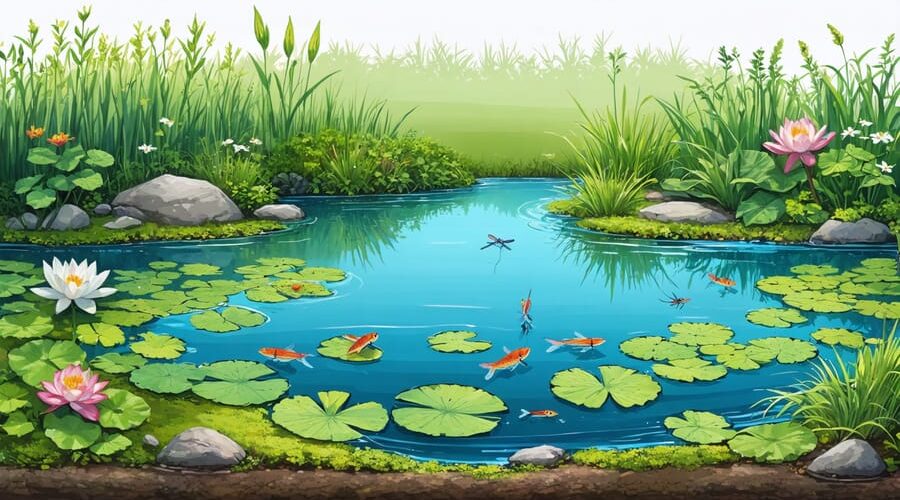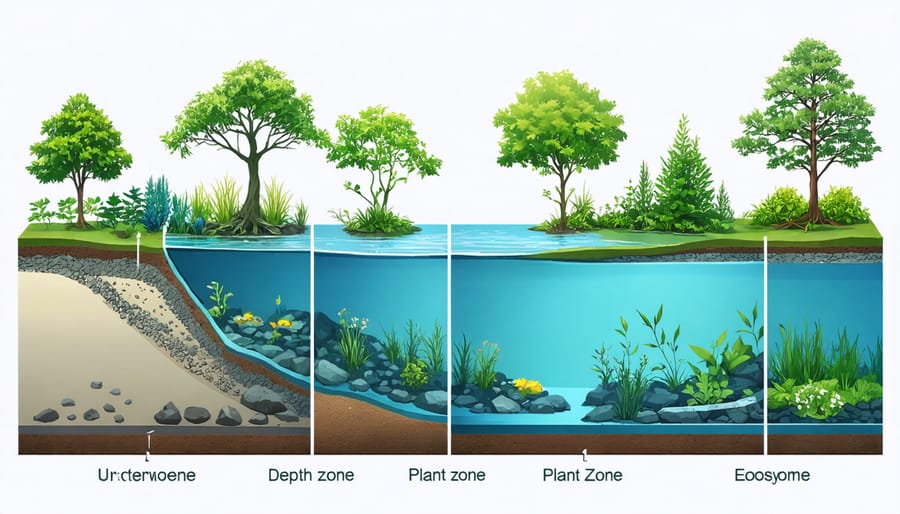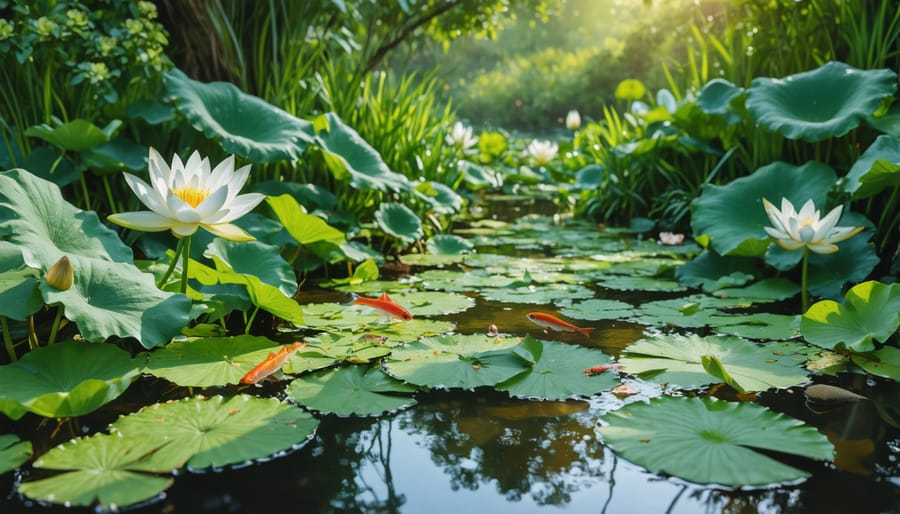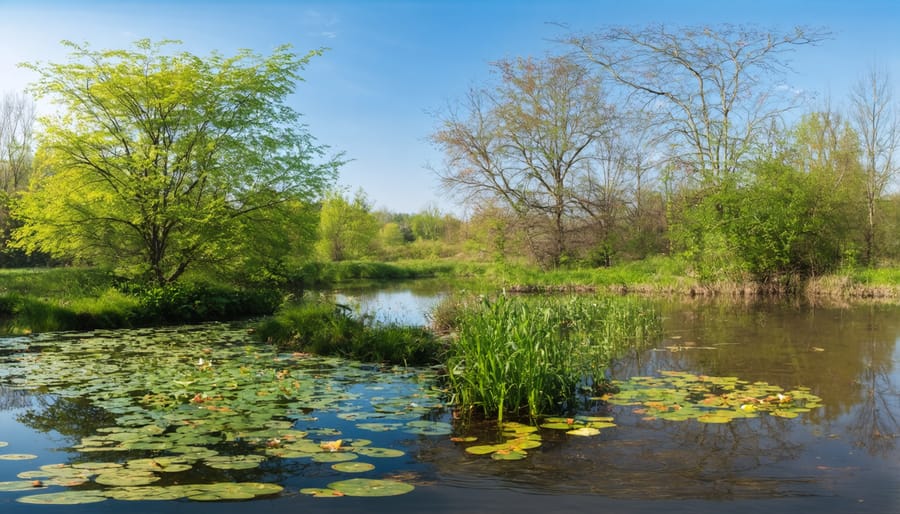
Create a Thriving Ecological Pond That Maintains Itself (Almost!)
Imagine a living, breathing ecosystem right in your backyard – that’s the magic of an ecological pond. Unlike traditional water features, these natural swimming pools create a perfect harmony between aesthetics and biodiversity, supporting everything from vibrant water lilies to darting dragonflies. By mimicking nature’s own filtration systems through carefully selected aquatic plants and beneficial bacteria, ecological ponds maintain their own balance with minimal human intervention.
Whether you’re dreaming of a serene garden centerpiece or a chemical-free swimming area, these self-sustaining water features offer a sustainable alternative to conventional pools and decorative ponds. Through strategic design that incorporates shallow marshes, deep-water zones, and native vegetation, ecological ponds create multiple micro-habitats that work together to keep water crystal clear naturally.
The best part? These living ecosystems become more beautiful and resilient over time, attracting local wildlife while requiring far less maintenance than traditional water features. As more homeowners seek environmentally conscious landscaping solutions, ecological ponds stand out as a perfect blend of natural beauty, sustainable design, and wildlife conservation.
The Natural Balance: Key Elements of an Ecological Pond
Plants: Nature’s Filtration System
In a natural pond ecosystem, plants are the unsung heroes that keep your water crystal clear and healthy. By implementing smart planting strategies, you can create a self-sustaining filtration system that works around the clock.
Floating plants like water lilies and lotus provide essential shade, reducing algae growth while adding stunning visual appeal. Just below the surface, submerged oxygenators such as hornwort and anacharis work tirelessly to absorb excess nutrients and release vital oxygen into the water.
Along the edges, marginal plants like iris and rush create a natural transition between water and land. Their robust root systems act as powerful filters, trapping debris and processing harmful compounds. Deep-rooted emergent plants, including cattails and bulrushes, are particularly effective at removing nitrogen and phosphorus from the water.
For the best results, aim to cover about 60% of your pond’s surface with a mix of these plant types. This balance ensures effective filtration while maintaining enough open water for fish and wildlife to thrive.
The Living Waters
The real magic of an ecological pond happens beneath the surface, where millions of beneficial microorganisms work tirelessly to maintain water quality and ecosystem health. These tiny heroes include bacteria that break down organic waste, algae that produce oxygen, and various microscopic creatures that form the base of the pond’s food chain.
Beneficial bacteria are particularly important, as they convert harmful ammonia from fish waste into less toxic compounds. They colonize your pond’s surfaces – rocks, plants, and filter media – creating an invisible but essential biological filter. Different types of bacteria work together: some break down leaves and plant matter, while others help maintain crystal-clear water.
The key to supporting these helpful microorganisms is maintaining proper oxygen levels and providing adequate surface area for them to colonize. This is why many pond owners include features like waterfalls or air pumps, and why it’s crucial to avoid harsh chemicals that could harm these beneficial populations.
A healthy microorganism community creates a self-sustaining ecosystem where nature does most of the maintenance work for you, resulting in clearer water and healthier plants and fish.
Designing Your Ecological Pond for Visual Impact

Natural Zones and Depth Variations
A well-designed ecological pond features distinct zones that mirror natural water bodies, creating a harmonious environment for various aquatic life. The key is to establish four main depth zones: marsh, marginal, shallow water, and deep water.
The marsh zone, typically 0-2 inches deep, creates a gentle transition from land to water. This area is perfect for moisture-loving plants and provides essential habitat for beneficial insects. Using ideal planting media here helps establish bog plants that filter water naturally.
Marginal zones, ranging from 2-6 inches deep, support striking plants like iris and rushes while offering safe spaces for small wildlife. The shallow water zone (6-12 inches) is where water lilies thrive and where fish find protection among submerged plants.
The deep water zone (2-4 feet) is crucial for pond stability. It provides cooler temperatures during summer, prevents freezing in winter, and gives fish a safe retreat. Create this zone in about 30% of your pond’s area.
When shaping these zones, use gentle slopes rather than sharp drops – aim for a 3:1 ratio (three feet horizontal for every foot vertical). This natural grading not only looks more appealing but also prevents soil erosion and provides safe access for wildlife.
Edge Design and Integration
Creating seamless edges for your ecological pond is crucial for achieving a natural, harmonious look in your landscape. Instead of sharp, artificial boundaries, focus on creating natural pond shapes that mimic those found in nature, with gentle curves and varying depths along the edges.
Start by laying a mix of different-sized rocks and boulders along the pond’s perimeter, positioning larger stones at key viewing points and gradually transitioning to smaller ones. This creates a more organic look while helping to secure the pond liner. Tuck hardy marginal plants between the rocks to soften edges and provide natural transitions from water to land.
Consider creating shallow shelves or beaches at different depths around the edge. These graduated zones not only look more natural but also provide essential habitat for wildlife and support a wider variety of plants. Add gravel or small stones in these areas to create a more realistic appearance and provide surfaces for beneficial bacteria to colonize.
For a truly integrated look, extend your planting beyond the pond’s immediate edge. Use native grasses, perennials, and small shrubs to blur the boundary between pond and garden. This approach not only looks beautiful but also creates valuable ecological corridors for wildlife moving between water and land environments.
Remember to leave some areas easily accessible for maintenance while keeping the overall design flowing and natural-looking.
Building a Self-Sustaining Ecosystem

Selecting Compatible Fish Species
Selecting the right fish species is crucial for maintaining a healthy ecological pond ecosystem. The key is to choose fish that not only look beautiful but also contribute to the natural balance of your water garden. Start with hardy species like Golden Rudd or Roach, which help control mosquito larvae and excess algae while being relatively low-maintenance.
For larger ponds, consider introducing a few Koi carp, but be mindful that they can disturb bottom sediments and impact your creative aquatic plant design. A better choice for smaller ponds would be smaller fish species like White Cloud Mountain Minnows or native fish that are adapted to your local climate.
Stocking density is just as important as species selection. A good rule of thumb is to allow about 50 gallons of water per inch of fish. This prevents overcrowding and maintains water quality naturally. Consider adding bottom-feeders like Weather Loaches, which help keep the pond floor clean while adding movement and interest to your water feature.
Remember to introduce fish gradually, allowing the pond’s ecosystem to establish itself first. Start with just a few hardy fish and observe how they interact with your pond environment. You can always add more later as the biological balance stabilizes. Avoid mixing aggressive species with peaceful ones, and ensure all chosen species can tolerate similar water conditions.
For the best results, select fish that complement each other’s roles in the ecosystem – some for algae control, others for insect management, and a few for bottom cleaning. This creates a self-sustaining system that requires minimal intervention while maintaining crystal-clear water naturally.
Natural Filtration Methods
Natural filtration in an ecological pond works like nature’s own cleaning system, creating a balanced ecosystem that practically maintains itself. The key to successful natural filtration lies in using a combination of carefully selected plants and beneficial bacteria.
Aquatic plants are your pond’s primary natural filters. Water lilies, cattails, and rushes absorb excess nutrients that could otherwise feed algae. Plant about one-third of your pond’s surface with floating plants, which help shade the water and reduce algae growth. Along the edges, marginal plants like iris and pickerelweed not only filter water but also provide crucial habitat for beneficial insects and amphibians.
Creating a dedicated bog filter area is another effective method. This shallow section, filled with gravel and dense plantings, acts as a biological filter as water flows through it. The gravel provides surface area for beneficial bacteria to colonize, while plants extract nutrients from the water.
A rock bottom layer serves multiple purposes in natural filtration. Use varying sizes of rocks and gravel to create different zones where beneficial bacteria can thrive. These bacteria break down fish waste and other organic matter, converting them into nutrients that plants can use.
For optimal results, include a small waterfall or stream feature. Moving water increases oxygen levels, which helps beneficial bacteria flourish and creates a healthier environment for fish and plants. The sound of flowing water also adds a peaceful element to your garden.
Remember to start with a modest fish population, as too many fish can overwhelm even the best natural filtration system. As your pond matures, the ecosystem will become more stable and efficient at maintaining clean, clear water naturally.
Seasonal Care for Your Ecological Pond

Spring and Summer Management
Spring and summer are the busiest seasons for your ecological pond, requiring regular but gentle maintenance to keep the ecosystem thriving. As temperatures rise, monitor water levels weekly and top up with rainwater when needed. Remove any dead plant material and trim back fast-growing aquatic plants to prevent them from taking over.
Watch for algae blooms, which are common in spring. Instead of using chemicals, add more floating plants like water lilies to provide shade and compete with algae for nutrients. Your pond’s beneficial bacteria will become more active as the water warms up, helping to maintain crystal-clear water naturally.
Early summer is perfect for introducing new plants and checking on your fish if you have them. Keep an eye on oxygen levels, especially during hot spells – if fish are gasping at the surface, consider adding an air pump or water feature to increase aeration.
Don’t forget to maintain the pond’s edges, where valuable wildlife habitats exist. Trim surrounding vegetation carefully, leaving some longer patches for creatures like frogs and newts. Remove fallen leaves promptly to prevent excess nutrient buildup, but leave some natural debris for insects and amphibians.
Test water quality monthly during these active seasons, checking pH and ammonia levels. Remember, a healthy ecological pond shouldn’t need frequent intervention – your role is mainly to observe and make minor adjustments to support nature’s own balance.
Fall and Winter Preparation
As fall approaches, it’s time to prepare your ecological pond for the colder months ahead. Start by removing fallen leaves regularly – they can decompose and affect water quality. A pond net stretched across the surface works wonders in catching debris before it sinks.
Trim back any dying aquatic plants, leaving about 2-3 inches above the water line. This prevents excess organic matter from decomposing in the water while preserving the plants’ root systems. If you have water lilies, cut back their dying leaves and let them naturally sink to the bottom where they’ll protect the rhizomes.
For regions with harsh winters, consider installing a pond heater or aerator to maintain a small opening in the ice. This allows for proper gas exchange and prevents toxic buildup under frozen surfaces. Don’t break ice that forms naturally – the shock waves can stress or harm hibernating fish.
Speaking of fish, reduce feeding as temperatures drop. When water temperatures consistently fall below 50°F (10°C), stop feeding altogether. Your fish will naturally slow down their metabolism and survive on existing pond nutrients.
Check your pond’s depth – a minimum of 2 feet is recommended for winter survival of fish and other aquatic life. In early fall, remove any pumps or filters that might be damaged by freezing temperatures, but keep the aerator running if you have one. This preparation ensures your pond ecosystem remains healthy through winter and ready for spring revival.
Creating an ecological pond is more than just building a water feature – it’s about crafting a living ecosystem that enriches your outdoor space and supports local wildlife. Throughout this guide, we’ve explored how to design, construct, and maintain a balanced aquatic environment that’s both beautiful and sustainable.
Remember that successful ecological ponds rely on the perfect balance of plants, fish, and beneficial microorganisms. By following the natural principles we’ve discussed, you can create a self-sustaining system that requires minimal intervention while providing maximum enjoyment. From selecting the right location to choosing appropriate native plants and maintaining proper water quality, each element plays a crucial role in your pond’s success.
Don’t be intimidated by the initial planning and setup process. Start small if you’re unsure, and expand your pond as you gain confidence and experience. The rewards of creating your own ecological pond are well worth the effort – imagine watching dragonflies dance across the water’s surface, hearing the gentle splash of fish, and enjoying the vibrant colors of water lilies in bloom.
Whether you’re looking to enhance your garden’s biodiversity, create a peaceful retreat, or simply enjoy the therapeutic benefits of water features, an ecological pond offers all these benefits and more. Take the first step today in your pond-building journey, and join the growing community of ecological pond enthusiasts who are making their outdoor spaces more sustainable and beautiful.
